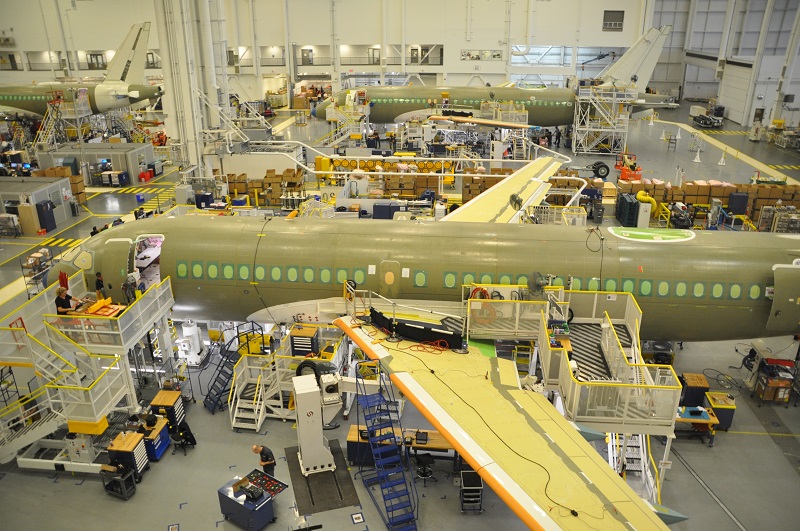The Airbus A220 is ready for thin long-haul routes such as trans-Atlantic flights.
That’s what Rob Dewar, head of customer service and engineering and “Father of the CSeries”, as the A220 was originally called, said in an exclusive interview at the A220 production site in Montréal, Canada.
“We got ETOPS certifications for the A220 to do trans-Atlantic flights and we can go both ways without payload restrictions,” he told AirlineRatings.
“We have a fantastic cabin and baggage capacity for a long haul flight. And if it’s not mass orders, we have delivery positions available for 2020 or 2021.”

That compares with Airbus or Boeing, where narrow-bodies are sold out for many years to come.
The force behind the ETOPS180 certification for overwater routes of up to three hours flying time away from the next alternate airport was A220 customer Korean Air.
“At the moment Korean Air flies only within the region, but they want to expand their A220 network to the Pacific,” Dewar said.
For transatlantic flights ETOPS120 is sufficient, allowing routes that are up to two hours away from the next airport.
“London City Airport to New York is a classic that we already tested, we can do it non-stop in both directions, but the airport can only take the smaller A220-100 which makes it more suitable for an All-Business-Class high-yield type of flight,” Dewar noted.
British Airways offers such a product on the route operating an Airbus A318 but this has to do a refuelling stop in Shannon westbound.
“But there is also a lot of secondary-to-secondary airport transatlantic routes the aircraft could do in a full commercial variant,” Dewar added. “It will eventually come, and there are certain routes where it would make a lot of sense.”
READ: Airbus enters new era as Faury takes the helm
Low-cost airlines such as Norwegian have recently started transatlantic flights for example between Ireland and secondary US East Cost airports using the 737 MAX 8.
For airlines such as Air Canada, the question about smaller aircraft for transatlantic flights is very acute, as the Canadian airline had to suspend its new 737 MAX 8 route from Halifax to London-Heathrow after the grounding.
The A220-300 can only take a maximum of 160 passengers over 5,740 km, however, while the 737 MAX 8 hauls up to 200 people over 6,570 km.
Airbus took a 50.01% majority of the former Bombardier CSeries On July 1, 2018, and on June 1 this year the joint venture will be renamed as Airbus Canada Partnership.
While nothing much seems to have changed at first sight at the production site in Canada, besides altered company signs and 50 expats sent from Airbus, things are different on the inside.

“A lot has changed since Airbus came in, most of all in the perception of the program now having a future,” said Dewar, who has worked for Canadair and Bombardier since 1986 with interruptions.
Aircraft sales, however, have been meagre, with firm orders currently at 536 and deliveries standing at 65 aircraft by the end of March.
On the day of last year’s Airbus takeover, JetBlue and start-up Moxy each signed for 60 aircraft but nothing has been added to the order books since.
More orders are paramount.
An important Airbus objective was to use its bigger leverage to lower supplier costs by 20 per cent and make the price tag for the A220 more attractive.
“Most suppliers are very receptive and we have made some progress since Airbus took over,” Dewar noted.
“It’s still a lot of challenges, cost reductions are not easy, but the initial indications are positive.”
He didn’t want to speculate when the next sales could be announced.
“There is a lot of momentum and sales do take time,” he said. “We are optimistic for the Paris Air Show in June. Often sales are linked to air shows, we’d rather do it consistently, but unfortunately, that’s not what happens.”
This year Airbus wants to deliver 45 A220s from Mirabel, after 33 in the previous year and 17 in the first year, 2017.
“That’s a relatively fast ramp-up, luckily we had no major supplier issues besides part shortages causing a few weeks of shift to deliveries,” Dewar said.

A second assembly line for the A220 is currently being built at the Airbus site in Mobile/Alabama in the US, which will deliver aircraft from the third quarter 2020 to Delta Air Lines and other US customers.
Mirabel currently builds four aircraft a month but capacity is sufficient for a rate of ten a month. Mobile will start with one aircraft per month, increasing to four in 2024/2025.
Overall, Dewar is pleased with the integration process of the former CSeries into the Airbus family.
“We have a lot more autonomy than what you would have in a normal Airbus program,” he said. “And they have been very smart and respectful of how to do the integration.”
However, it appears to be slightly more difficult for the new brand name to sink in within the industry and for the general public.
“Even myself I sometimes still refer to CSeries,” Dewar admitted.
Meanwhile the attitude of launch operator Swiss, part of Lufthansa Group, appears slightly anachronistic as the airline still advertises the aircraft as CSeries.
“Swiss will re-brand when they think the time is right, while the second A220 operator Air Baltic is more avant-garde in their marketing, they did it overnight,” Dewar observed.
























